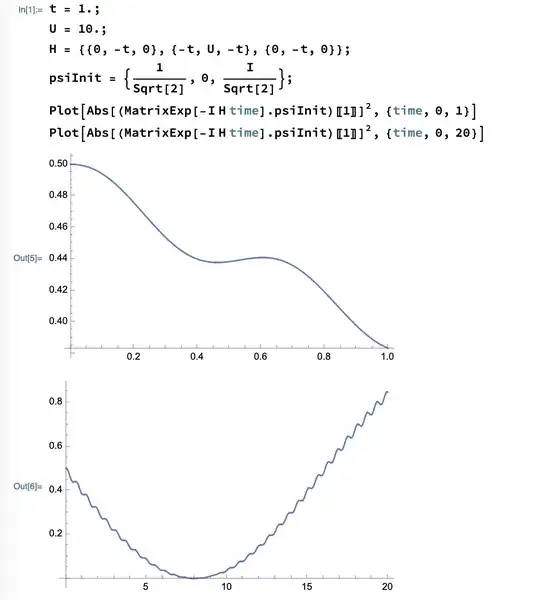My question is related to, but different from, other questions in this platform (see this, this and this).
One of the few places I have found in literature that provide a microscopic derivation of the Josephson Effect is in section 18.7 of Bruus & Flensberg. In the book, the authors consider two superconducting leads at different phases $\phi_c$ and $\phi_f$. The unperturbed Hamiltonian for the lead $c$ is \begin{equation} H_c = \sum_{k,\sigma} \epsilon_k c_{k\sigma}^\dagger c_{k\sigma} - \sum_{k}(\Delta e^{-i\phi_c}c^\dagger_{k\uparrow}c^\dagger_{-k\downarrow}+\Delta e^{i\phi_c} c_{-k\downarrow}c_{k\uparrow}), \end{equation} with an equivalent one holding for the lead $f$. They then introduce term to allow for fermion tunneling between the leads \begin{equation} H_t = \sum_{k,p,\sigma} (tc^\dagger_{k\sigma} f_{p\sigma}+t^* f^\dagger_{p\sigma} c_{k\sigma}). \end{equation}
They then calculate the current through the leads as \begin{equation} I_J = \langle I \rangle = -e \langle \dot{N}_c \rangle = -2e \bigg\langle \frac{\partial H_t}{\partial \phi}\bigg\rangle. \end{equation}
As I understand, to get the last equation one uses the Heisenberg equation of motion $\dot{N}_c = -i[N_c,H]$, where $N_c$ is the occupation number operator in the superconducting lead $c$, followed by the use of the identification $N_c - N_f = -i \partial_\phi$ together with some constraint $N_c + N_f = N \in \mathbb{Z}$.
This already I find quite problematic. I have read in some sources that the identification $N = - i \partial_\phi$ is mathematically inconsistent. So, how can we trust any results that rely on it? In particular, what justifies the use of this identity here?
Even if we ignore this problematic step, there is another detail I would like some clarification on.
Let us start from the second equality in the current equation. We use the Heisenberg equation and arrive at \begin{equation} I_J = i e \langle [N_c,H_c + H_f + H_t] \rangle. \end{equation}
The expectation value above needs to be evaluated according to some state (or distribution). The authors do not specify what it should be, so I think the simplest assumption is that the state are thermal states of the unperturbed Hamiltonian $H_0 = H_c + H_f$. At zero temperature, this reduces to the BCS ground state $H_0 |GS(\phi_c, \phi_f)\rangle = E_0 |GS(\phi_c, \phi_f)\rangle$, where \begin{equation} |GS(\phi_c, \phi_f)\rangle = \tfrac{1}{\mathcal{N}} e^{\Lambda_c^\dagger(\phi_c)} e^{\Lambda_f^\dagger(\phi_f)} | 0 \rangle, \end{equation} where the exponentials create BCS condensates on each lead separately. With this assumtpion, the $H_c + H_f$ term in the commutator vanishes in the expression for the current, since it acts on the ground state to become a number. We are then left with having to calculate $[N_c,H_t]$. After some dull but straightforward calculation, we find \begin{align} [N_c,H_t] &= \sum_{k, p, \sigma} \sum_{q, \tau} [c^\dagger_{q\tau} c_{q \tau}, (tc^\dagger_{k\sigma} f_{p,\sigma}+t^* f^\dagger_{p\sigma} c_{k,\sigma})] \\ &= \sum_{k, p, \sigma} \sum_{q, \tau} \delta_{q\tau, k\sigma} \left( t c_{q\tau}^\dagger f_{p\sigma} - t^* f_{p\sigma}^\dagger c_{q\tau} \right) \\ &= \sum_{k, p, \sigma} \left( t c_{k\sigma}^\dagger f_{p\sigma} - t^* f_{p\sigma}^\dagger c_{k\sigma} \right). \end{align} Here comes the issue: although $|GS(\phi_c, \phi_f)\rangle$ has an ill-defined particle number, it should have a definite fermion parity. In fact, each condensate $c,f$ should have a well defined fermion parity. Moreover, the operator from the expression above flips the fermion parity in each condensate (since it hops a single fermion from one region to the other). This means that the state \begin{equation} [N_c,H_t]|GS(\phi_c, \phi_f)\rangle \end{equation} must have the opposite fermion parity in each condensate, which means it must be orthogonal to $|GS(\phi_c, \phi_f)\rangle$ itself. In other words, this calculation seems to imply \begin{equation} I_J = i e \langle GS(\phi_c, \phi_f) | [N_c,H_t]|GS(\phi_c, \phi_f)\rangle = 0. \end{equation}
The current must be identically zero! Even though the calcultion through the original method seemed to imply otherwise.
How can this apparent paradox be resolved?
